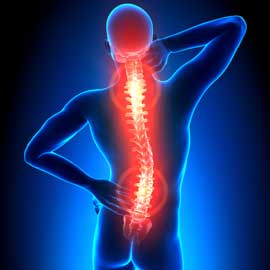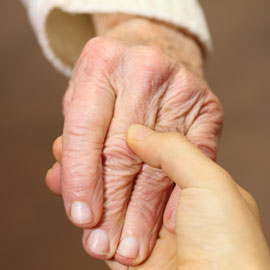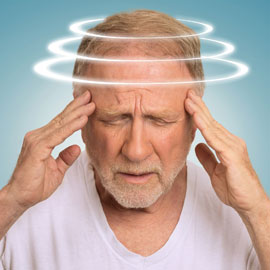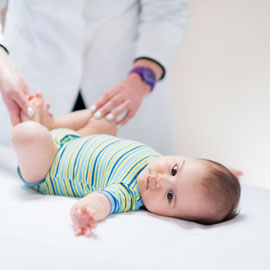Neck and Back Pain
Causes and Physical Therapy Treatments
Neck and back pain are both very common ailments today in children, young adults and the elderly. From working while sitting in chairs all day, to excessive use of handheld electronics that force us to alter how we angle our bodies, neck and back pain can be typical. In fact, according to a CBS News report, texting on a cell phone can cause between 12 and 60 pounds of additional pressure on the neck depending on the angle of the user’s neck. The same can be true for using computers because if the spine is not correctly aligned and the back is rounded, the cumulative effect can lead to back and neck issues. However, neck and back pain can be due to various other reasons and be chronic as well.
From slips and falls, to car accidents and medical conditions, any of these can cause longer lasting neck and back pain. For example, even a minor car crash at 30mph or less can cause whiplash, which is an abrupt jerking motion of the head and neck in the backward or forward direction. Whiplash can cause neck strains and stiffness, as well as lower back pain. Neck and back pain, however, can come from more than just accidents.
There are people who have back issues due to medical conditions. Whether self-inflicted or not, medical issues can be structural ones. A misalignment of the spine, for example, could just be the way a person's body is structured and can cause complications. Or, being overweight, no matter how someone gets there, can put strain on the neck and back as well. Additionally, things like disc bulges and hernias cause back pain in all body types. The overall wear and tear on the body over the years is likely to cause back and neck issues that will lead to pain.

As we age, the jellylike discs between our vertebrae that act like shock absorbers to stop them from touching each other start to wear away and shrink. This can result in the vertebrae coming into contact with each other. Bone-on-bone contact can cause discomfort and pain. For example, if you live with a medical condition like diabetes, which causes inflammation, the bones come into contact without the jellylike protection. These are just a few examples, however, the causes for neck and back pain can result from many different types of conditions. Below is a longer list of neck and back pain causes as listed by Johns Hopkins Hospital:
- Overuse, strenuous activity, or improper use, such as repetitive or heavy lifting
- Trauma, injury, or fractures
- Degeneration of vertebrae, often caused by stresses on the muscles and ligaments that support the spine, or the effects of aging
- Abnormal growth, such as a tumor or bone spur
- Obesity due to increased weight on the spine and pressure on the discs
- Poor muscle tone
- Muscle tension or spasm
- Sprain or strain
- Ligament or muscle tears
- Joint problems, such as arthritis
- Protruding or herniated (slipped) disc and pinched nerve
- Osteoporosis and compression fractures
- Congenital (present at birth) abnormalities of the vertebrae and bones
- Abdominal problems, such as an aortic aneurysm
Knowing the cause is a start. But understanding the diagnosis of the actual neck or back injury as a result of the cause is just as important as well. That lets your doctor and therapists treat it properly. Some of the more common injuries are strains and sprains of the neck and back muscles. Others include herniated discs, fractured vertebrae, and tendon injuries. Because the neck and back houses many of the nerves and muscles that are at the core of the human body, the list of possible injuries is long. No matter what the injury, proper treatment is important. And one common type of treatment most prescribed is physical therapy.
Physical therapy helps to work on several aspects of the back and neck pain. From range of motion limits, to relieving the pain, to making the muscles stronger to help protect the affected area, physical therapy takes the patient through a series of treatments where he or she can experience the best possible results. There are many modalities physical therapists use to treat neck and back pain.
Treatment usually starts with an evaluation of the patient’s history, reason for visiting, and a number of measurements to assess things like range of motion, pain tolerance, and therapeutic aims. From there, visits may include some of the following types of treatments:
- Ice and heat
- Electric stimulus
- Massages and stretching exercises
- Ultrasound
- Trigger point release
- Stretching and range of motion exercises
- Specific strengthening exercises
- Pain relief exercises
- Low impact aerobic conditioning
Each treatment method has a different goal. Some will be combined in one session. Your physical therapist will discuss the treatment plan and how it is helping in more detail based on your specific injury. However, the ultimate goal is to get you moving with little to no pain and start enjoying your life again, pain free.
Neck and Back Pains?
Call us today and find out how we can help relieve the pain
What our patients say

I have been coming to RT Physical Therapy & Rehab for over a year and highly recommend this office!!! On 3 separate occasions, during the year, I came to be treated for neck injury, heel spur and vertigo/dizziness. Each time Reuven & his staff have taken great care of me and have shown me exercises to do when I'm home to minimize pain and/or to eventually fix my problem.

I came to RT for physical therapy with a horrible pain in my neck that radiated all the way down my arm. Couldn't drive or do anything. After only 3 sessions Reuven transformed me back to my active self. Highly recommend this office!! Staff is also super professional!!!

I went to Reuven for knee pain. I have never met a more caring and dedicating health care provider in my life! He knew exactly what I had to do to reduce the pain in my knee and helped me get back to playing sports without pain. The whole staff was very nice and helpful. I would 100% return here the next time I need physical therapy.



